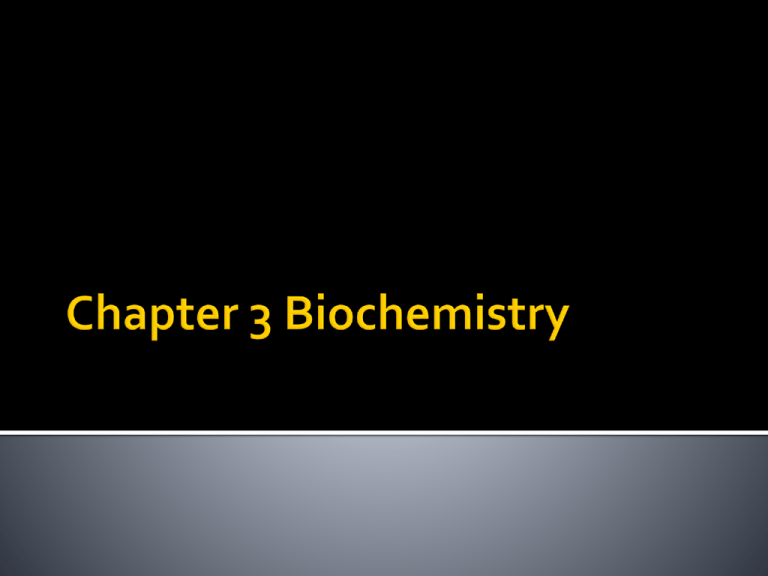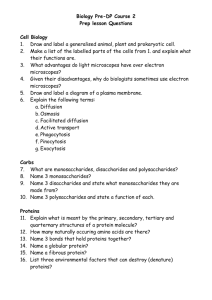Chapter 3
advertisement

Organic molecules are carbon based There are many different organic molecules Simplest organic molecules- hydrocarbons Diverse Organic Molecules are possible because carbon can bond to carbon and form Long chains Ring structures Single , double or triple bonds isomers We can form many different carbon skeletons Others groups of atoms are added to the carbon skeleton to create molecules with different chemical properties- Functional groups Carboxyl – weak acid, in acids, including amino acids Carbonyl- polar, found in ketones and aldehydes, sugars Hydroxyl- polar, in alcohols Amino- weak base, found in amino acids Phosphate- polar, found in DNA and the energy molecule ATP Four classes of organic macromolecules Carbohydrates Lipids Proteins Nucleic Acids Carbs, Proteins and Nucleic acids are polymers Polymer- a large molecule consisting of many smaller similar subunits called monomers Polymers are formed by connecting monomers in a dehydration reaction. This produces water as a waste. Polymers are digested by adding water and creating monomers- Hydrolysis reaction 1. Monosaccharides 2. Disaccharides 3. Polysaccharides Molecular formula- CH2O Contain carbonyl and hydroxyl groups building blocks of disaccharides and polysaccharides Glucose- main cellular fuel Fructose- fruit sugar Ribose, deoxyribose – sugars found in nucleic acids When two monosaccharides are linked by a dehydration reaction a discaccharide forms Glucose + Glucose = Maltose Glucose + Fructose = Sucrose Glucose + Galactose= Lactose Long chains of monosaccharides are polysaccharides Starch Glycogen Cellulose Chitin Lipids – also called fats or triglycerides Are hydrophobic- do not mix in water Made of glycerol and three fatty acids linked by dehydration synthesis May be saturated – have no double bonds so carbons have all of the hydrogens possible Unsaturated – at least one double bond, missing hydrogens Fats store energy (2x as much as an equal mass of carb) Waterproof Cushion Insulate Come from animals Are solids at room temp Are generally not very healthy for you and should be limited in your diet Come from Plants (with one exception) and are liquids at room temperature Are generally healthier for us Polyunsaturated fats are found in some types of fish and have been found to help lower cholesterol. Liquid oils are turned into solids by adding hydrogens to them This process creates Trans Fat – which has been linked with heart disease Is in most baked goods The building of lipid deposits in artery walls Reduces blood flow Plays a role in heart disease Waxes- one fatty acid linked to an alcohol Phospholipids- one glycerol, 2fatty acids and a phosphate in place of the third fatty acidmake up cell membranes Steroids are made of three 6 sided rings and one five sided ring Cholesterol is a steroid associated with saturated fat Estrogen and testosterone are made from cholesterol Synthetic testosterones which build bone and muscle mass May lead to mood disturbance, liver damage, high cholesterol, cardiovascular disease, in adolescents bones may stop growing, and acne and baldness (both are influenced by testosterone) Males will reduce the production of natural male hormone which may impair normal reproductive function and fertility. Females have very little testosterone in their system naturally so they may experience disrupted menstrual cycles, and develop male traits like facial hair, voice deepening etc






